Gold Stars
/in Gratitude Practice, Ideas, Life/by Catherine Haslag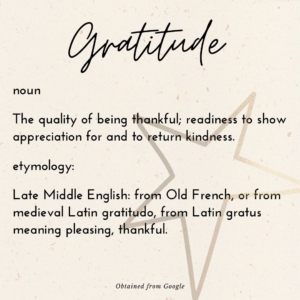 A gratitude practice became a part of my life a handful of years ago. At the time I started this practice all I could see was everything that was “wrong” in the world. I was wasting so much energy on what didn’t appear to be “right” and was looking for a way to shift that energy into something productive. Someone suggested that I cultivate a gratitude practice to shift my attitude and view of life. They challenged me to see the flowers on the wallpaper rather than focus on the cracks in the plaster.
A gratitude practice became a part of my life a handful of years ago. At the time I started this practice all I could see was everything that was “wrong” in the world. I was wasting so much energy on what didn’t appear to be “right” and was looking for a way to shift that energy into something productive. Someone suggested that I cultivate a gratitude practice to shift my attitude and view of life. They challenged me to see the flowers on the wallpaper rather than focus on the cracks in the plaster.
I am a researcher, so I started this work by reading a few books on gratitude (365 Thank Yous: The Year a Simple Act of Daily Gratitude Changed My Life and The Gratitude Diaries are two books I recommend on the subject). This led me to add some basic gratitude practices to my life. I started sending thank you notes on a regular basis to my friends and family (the Dollar Store has a good selection of Thank You cards that work perfectly for this). I sent thank-you notes for gifts, phone calls, kind words, friendship, and just to let others know that I thought they were awesome. I also wrote a few things I was thankful for each day in my journal. This helped me to spend time acknowledging the good things present in my everyday life.
As time went on, I started to see all the things there are to be thankful for, even on the crappiest of days. The hot cup of tea in the morning, the car that starts without issue, a clear, star-filled night sky, indoor plumbing on the coldest days during the Minnesota winter. I discovered that there is ALWAYS something to be thankful for and nothing was too small for gratitude. Over time, I realized it was the little things that could get me through the hardest of days.
My gratitude practice has grown over time. Early in the pandemic, a good friend of mine and I started ending our conversations by sharing “good things” in our lives. Hearing what she is thankful for has helped expand my view of all the things available to be grateful for in the world.
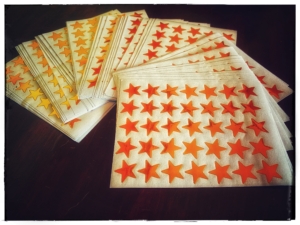 About halfway through lockdown in 2020, I decided to add something else tangible to my gratitude practice, so I brought the gold star back into my life. This was a simple, visible, and slightly quirky way for me to show gratitude to myself and those around me. It was also a way to spread a little childhood joy in the grind of adulthood.
About halfway through lockdown in 2020, I decided to add something else tangible to my gratitude practice, so I brought the gold star back into my life. This was a simple, visible, and slightly quirky way for me to show gratitude to myself and those around me. It was also a way to spread a little childhood joy in the grind of adulthood.
Many of us may be most familiar with the use of gold stars in the classroom. Gold stars would come to us on the top of an assignment we completed well, on a chart posted in the front of the classroom for good behavior, or in a loose form so we could put it on the front of our notebook or wear it on our shirt and show everyone how awesome we are. As a child, we loved to get those gold stars. It told us we had done something good and someone noticed our efforts and work. It was gratitude in a tangible form.
The gold star provided me with something visible to brighten up the day and restore some innocence to the challenges of 2020. I started sending gold star emojis and animations to friends via text for a job well done. I found some puffy gold stars at JoAnn’s and used them to decorate the inside of thank you cards. I ordered gold star stickers to share and included a sheet of them for each person in every family to whom I sent Christmas cards. It was fun sharing this simple joy. I wanted others to know that I saw them, I saw the good they were doing, and I thought they were awesome. Some of my family and friends commented on how the gold stars made their day. They too were taken back to the joys of receiving a gold star from their teacher for a job well done. I hope they shared their gold stars with others and kept spreading the gratitude. I have decided to keep a supply of gold stars on hand and bestow them to people on a regular basis as a way to say “thank you.”
There is an old story told by many indigenous tribes in North America that talks of a grandfather telling his grandson that there are two wolves fighting inside each of us. One wolf is evil and one wolf is good. The grandson asked his grandfather which wolf will win this battle. The grandfather said, “The one that you feed.”
I chose to feed the good wolf with gratitude and it was so simple to do. It can be shared through a symbol like a gold star or a thank you note, but it can also appear in less tangible forms: a pat on the back, saying thank you, or a kind smile to a stranger while shopping. There is no limit to gratitude. It never runs out and it costs us nothing to share.
Fool’s Spring
/in Hiking, Life, Travel/by Catherine Haslag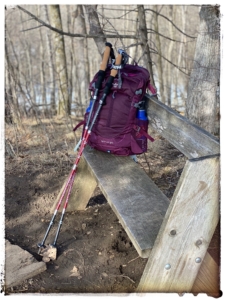 This past week, we experienced several days of temperatures in the upper 40s to low 60s. The snow is mostly melted, leaving behind enough sand to build our own beach along the Cedar River and some very, very brown grass. People are out walking in shorts, some green things are starting to peek out from the ground in the flower bed along my house, and a few trees have buds swelling in expectation. I even saw a few bugs buzzing about, much to my dismay. The smell of spring is in the air…until Tuesday when winter returns with a rain/snow mix and temperatures start to drop into the 30s again.
This past week, we experienced several days of temperatures in the upper 40s to low 60s. The snow is mostly melted, leaving behind enough sand to build our own beach along the Cedar River and some very, very brown grass. People are out walking in shorts, some green things are starting to peek out from the ground in the flower bed along my house, and a few trees have buds swelling in expectation. I even saw a few bugs buzzing about, much to my dismay. The smell of spring is in the air…until Tuesday when winter returns with a rain/snow mix and temperatures start to drop into the 30s again.
This week of warm and melty weather is what many refer to as “Fool’s Spring,” a time of the year that feels like spring is just around the corner, but in reality, it’s just Mother Nature and Old Man Winter playing a joke on all of us. A few days of sun, a little warmth, and the phase-change of water lull us into a false sense that spring is nearly here…then winter returns and we are back to snow boots and icy roads.
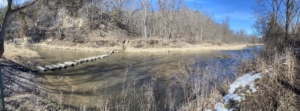
View of the Coyote Point Trail at Whitewater State Park.
While Fool’s Spring is fleeting, it is especially necessary and celebrated by me this year. Winters in Minnesota are always hard. They can be brutally cold, grey, and snowy. Every time I leave my house I do my best impersonation of the little brother from A Christmas Story.
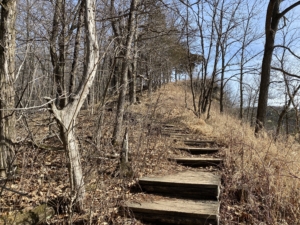
The very long climb to the look-out point.
People tend to hunker down in the winter months. Social circles contract because people aren’t out and about as much. It takes energy to bundle up, dig the car out, scrape it off, and drive somewhere in the winter, so people do it less. Because of the pandemic, people did it even less this year, at least this is true for me and those in my social circle. No lunch with friends on a Friday to catch up, no bull sessions over drinks at the B&J on Thursday afternoons, no working at a coffee shop for a few hours just to be around people. If you live alone, this winter has probably sucked the big one more so than usual.
I took the opportunity Fool’s Spring provided to get out and hike a bit. I visited a very soggy Whitewater State Park. Despite the muddy, icy, and snowy trails (in some places all of these at the same time) it felt so good to get out, move my body, and breathe in the fresh air. I hiked up a set of stairs that extended approximately 0.2 miles to a lookout point. I sat at the very wisely-placed bench at the top of these stairs and enjoyed the view, felt my heart pound, and drank some water. It felt so good to feel my heart pushing blood through my body and fresh breath in my lungs. It was like this winter was starting to melt inside of me as well as on the land around me.
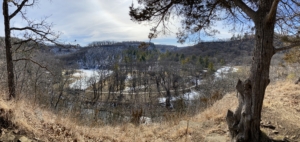
View from the look-out point.
This first Fool’s Spring provided a break from the cold, grey days. It gave me the chance to shed my winter shell and thaw a bit from the past few months. I not only needed to warm my body, but also tend to my heart. Emotions have been high for me for a lot of reasons over the past year. I know I am not the only one on this either. The fresh air, the sun on my face, and the feel of sneakers on my feet rather than snow boots is a boost to my morale. The opportunity to recharge a bit before finishing out the winter season. A shimmer of hope that this winter won’t last forever, that spring will be here soon.
Fool’s Spring is a promise to us all. Better times are ahead. We just have to be patient and wait a little bit longer.
Aunt Jo’s German Chocolate Cake
/in Life/by Catherine Haslag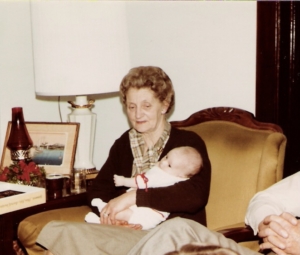
My Aunt Jo holding baby me circa 1980.
My Aunt Jo made a three-layer German Chocolate Cake from scratch. About 9 years ago, I obtained her recipe from my mom because I wanted a way to connect with Aunt Jo. I wanted to create something she once did. I didn’t like her cake when she was alive to make it because I was too young to appreciate coconut and chocolate cake. Thankfully, my dessert appreciation has matured since I was 7. I loved my Aunt Jo. She always had those yellow Brach butterscotch candies in a dish and she let me play on her organ and piano when I came over. All the stops on the organ fascinated me and I loved to flip them in different combinations and see what sounds I could make. I must have made all kinds of horrible noises during my musical experiments, but I don’t ever remember her telling me to stop.
Mostly, I remember how much I loved her. The kind of pure, endless love only a little kid shows. The kind of love that hasn’t been damaged by hurt, disappointment, and time. When I bake her cake, I am reminded of that love, of her, of her carpet on my feet, and the noises I made on her organ. It’s a way to connect with someone I love and barely know. A way to keep her alive. When I share that cake with others, I share her and the love I have for my Aunt Jo.
Below is the recipe my Aunt Jo used. It was straight off the box of Baker’s German chocolate (which I didn’t know until I wrote this post). It is best made as a 3-layer cake but can be made in a 9×13 pan, which is much easier to transport. May you bake this treat and share it with those you love.
GERMAN’S SWEET CHOCOLATE CAKE
Used by Aunt Josephine Samson
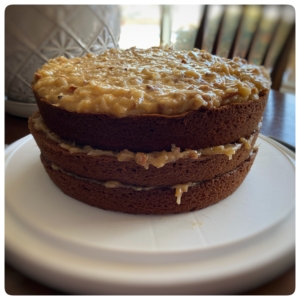
Aunt Jo’s three-layer German Chocolate cake.
Ingredients:
1 pkg. (4 oz.) BAKER’S GERMAN Sweet Chocolate
½ cup water
4 eggs, separated
2 cups flour
1 tsp. baking soda
¼ tsp. salt
1 cup butter, softened
2 cups sugar
1 tsp. vanilla
1 cup buttermilk
Procedure:
HEAT oven to 350°F.
COVER bottoms of 3 (9-inch) round pans with waxed paper; spray sides with cooking spray. Microwave chocolate and water in a large microwaveable bowl on HIGH 1 ½ to 2 min. or until chocolate is almost melted, stirring after 1 min. Stir until chocolate is completely melted.
BEAT egg whites in a small bowl with mixer on high speed until stiff peaks form; set aside. Mix flour, baking soda, and salt. Beat butter and sugar in a large bowl with a mixer until light and fluffy. Add egg yolks, 1 at a time, beating well after each. Blend in melted chocolate and vanilla. Add flour mixture alternately with buttermilk, beating until well blended after each addition.
ADD egg whites; stir gently until well blended. Pour into prepared pans.
BAKE 30 min. or until a toothpick inserted in centers comes out clean. Immediately run small spatula around cakes in pans. Cool cakes in pans 15 min.; remove from pans to wire racks. Cool completely. Spread Coconut-Pecan Filling and Frosting between cake layers and onto the top of the cake.
COCONUT-PECAN FILLING AND FROSTING
Time prep: 20 min
Total Servings: About 4-1/2 cups or 36 servings, 2 Tbsp. each
Ingredients:
4 egg yolks
1 can (12 oz.) evaporated milk
1 ½ tsp. vanilla
1 ½ cups sugar
¾ cup butter or margarine
1 pkg. (7 oz.) Baker’s Flake Coconut (2 2/3 cups)
1 ½ cups chopped Fischer’s Pecans
Procedure:
BEAT egg yolks, milk, and vanilla in a large saucepan with whisk until well blended. Add sugar and butter; cook on medium heat for 12 min. or until thickened and golden brown, stirring constantly. Remove from heat.
ADD coconut and nuts; mix well. Cool to desired spreading consistency. This is mix is also used between the layers of the cake.
What the Wind Told
/in Books, Life/by Catherine Haslag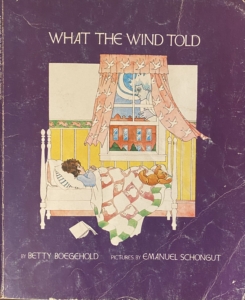
Cover of What the Wind Told by Betty Boegehold.
One of my favorite books of all time came into my life on a Halloween night. A neighbor lady worked at Scholastics and gave out candy and books to trick-or-treaters. I was the last kid to come to her house one year so I was the lucky recipient of half a crystal punch bowl of candy and a stack of books. A jackpot of massive proportions to someone who could still count their age and not use all their fingers to do so. One of the books in my acquisition was titled What the Wind Told.
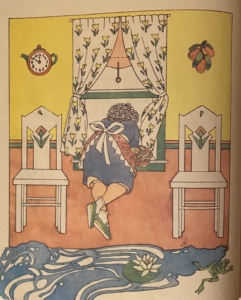
The story of the Old Woman’s Window.
Published in 1974 and written by Betty Boegehold, this book tells the story of Tossy, a little girl who is homesick and bored out of her mind. She eventually asks the Wind to tell her stories about the windows across the way to help her pass the time. The Wind tells Tossy stories of a woman whose kitchen floor turns into a pond during the day, a family of plants who keep their children on the window sill, and a dog who sits typing names for things all day long.
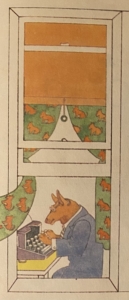
The story of the Old Dog’s Window.
What the Wind Told opened my child-mind to the idea that each window contains a story. I wanted to learn those stories. To this day, I enjoy touring other’s homes and looking at their houses as I walk down the street. Each window tells a story about the people who live there. The widower who hasn’t changed anything in the living room since his wife died. The family of 6 who lives in a 2-bedroom house. Bunk beds stacked in one bedroom with sheets in the windows for curtains. The retired neighbor who loves to sit on his 3-season porch and wave at passers-by. The immigrant family who purchased their first home and is chasing their American Dream.
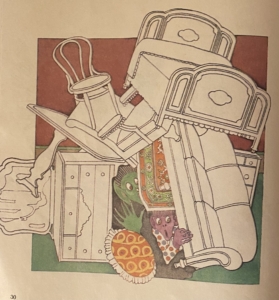
Drool and Gool hiding in the middle of their apartment, terrified.
More than 30 years later this book still inspires my imagination. A home a few doors down from where I live has captivated me for years. It reminds me of the Scary window described by the Wind. The windows are dark and the curtains are always drawn. I never see anyone come and go from the house. There is no car in the driveway or garage. There are never any tire tracks in the snow come winter and the sidewalk is never shoveled. Sometimes I see a cat in the window, staring back in boredom. There are decorations by the door and someone does live there, but there is no evidence of this other than the bored window cat and dumpster and recycling found weekly at the curb. Every time I walk by this house, I imagine that Drool and Gool are hunkered down in a pile of furniture in the living room, hoping no one calls or knocks.
Unfortunately, What the Wind Told is out of print and copies of it are very expensive. I am so thankful for the neighbor who gave me this book when I was a child. It sparked my imagination and taught me that windows are glimpses into others’ lives. The stories our windows tell about us are beautiful and incomplete. A glance at the private lives contained in our homes and hearts.
PLEASE NOTE: All photos used in this blog were taken from my copy of What the Wind Told and are not my personal work or of my creative labor. They were used in this blog to help communicate the essence of the book and provide an illustration of the stories the author was telling.
A VERY SPECIAL THANK YOU to Alvina Jaegers for the Halloween candy and books. Your house was my favorite to visit on Halloween night.
Memorex
/in Ideas, Life/by Catherine HaslagWhen I was 12, I was given a boom box for Christmas. I had always loved music and this was a tool to access the musical world. The boombox had an AM/FM radio, cassette tape deck, and a CD player component on it. My favorite feature of this gift was the ability to record songs from the radio onto a blank cassette tape. At that time, the only way to listen to music on demand was to own a recording of it on cassette or CD. The cheapest, but by far not the easiest, way to possess a recording of your favorite song was to record it off the radio. I had many mixtapes of my favorite songs for my efforts.
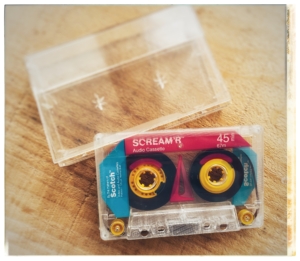
One of the blank cassette tapes I used to collect my favorite songs from the radio.
The quest to capture my favorite music from the radio took time and planning. I ALWAYS had a blank tape cued up in my cassette deck when I listened to the radio so I was prepared to press record when the latest Counting Crows or Bush song came on. I might spend weeks trying to get a song. Sometimes I couldn’t get to the record button fast enough to catch the start of the music. Other times I turned on my boom box only to find that a song I had been trying to record for weeks was in progress and I was just moments too late to capture it. I hunted for songs like a lepidopterist chases butterflies. DJs would sometimes talk through the intro or end of a song, so many of my radio recordings have the sound of DJ sprinkled in. I think DJs did this just to torture those of us trying to record from the radio.
When a cassette was full, I would listen to the songs over and over. I could rewind, pause, stop, and start at any point in the music I wanted. It was an amazing feeling to have built my own mixtape of sounds I loved. It was equally incredible that those cassettes survived the constant use of a teenage girl.
Now, we have almost any song we desire at our fingertips in an instant. When I was a teenager, I listened to the radio for hours a day. Now, I rarely listen to the radio. Spotify, Amazon, and my collection of MP3 music files are my go-to when I need to hear a beat. My boom box no longer has a blank cassette ready to record. Mixtapes have been replaced by playlists.
I still vividly remember most of the songs I captured from the radio on my mixtapes. I have created a 90’s Mix Tape Spotify Playlist so that I can reminisce about those times whenever I want.
When you listen to it, I hope you also hear a teenage girl lunge across her bedroom to hit record.
What I Didn’t Know
/in Books, Ideas, Life/by Catherine HaslagMay 25, 2020
I didn’t watch the full video. 8 minutes and 46 seconds. I saw parts of it, but not the whole tape. I can’t watch the video of George Floyd dying, of anyone dying.
I had the privilege of sitting with my feelings on this for a while. To learn more. To take it all in. I began reading. Looking. Researching for anything I could find.
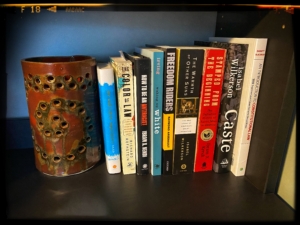
I found a mountain of information. Podcasts. Books. Videos. Theses. Documentaries. Journal articles. Newspaper pieces. Magazine reports. Websites. There was no end to the documentation. What I could read, view, and listen to. New information to learn, to shatter my old misunderstanding, and develop a new, more accurate picture.
I shouldn’t have been surprised by the deluge of resources I found, but I was. It was eye-opening. Once I started looking, learned so much about US history. More than in any class I took. Our history spells out the impact of racism and how far its tentacles stretched. Education, healthcare, housing, travel, restaurants, the GI Bill, voting rights, religion, policing, marriage, redistricting. There isn’t an area of life that isn’t affected by systemic racism. Every person in the United States has either benefited from or been disadvantaged by this disease.
There are many perspectives to history. The white perspective is the primary one told in this country because white is the dominant race, the dominant caste. There is a vast amount of US history that isn’t taught because it doesn’t paint white people in a positive light. This creates an incomplete and unfair narrative of our country, its history, and its people.
Redlining. Gerrymandering. Jim Crow. Segregation. Racial profiling. Stop and frisk. Voter ID. Poll taxes. Travel bans. Internment camps. Reservations. The war on drugs. All forms of racism make it harder for people of color to live their American dream. All efforts to keep the privilege in the hands of white people. White privilege. White power. White supremacy.
Equal rights have not been established. All lives don’t matter until all lives are treated like they matter. Black and brown lives don’t matter in the United States. Four hundred years of history demonstrates this. The evidence is there for anyone to see if one is open to seeing it.
I believe that the United States of America is a great country. I believe in the quest to form a more perfect union…more perfect union for ALL those who call the United States home. I also know that quest is a messy one. We are not a country of saints. Far, far from it. To paint this country as such is a lie and dooms us to repeat our sins of the past.
If you are open to learning about how systemic racism permeates our society, I encourage you to access the Google Docs link below. It is a file that contains the list of resources I found in my research on systemic racism. As I continue collecting resources, I will continue to update this document.
#SystemicRacism Resources Google Docs Link
These resources tell another side of US history, it’s not a pretty one but it’s true. My hope is that the research I have done will help open more eyes to the reality of our nation and those who are mistreated in it because of the color of their skin. My dream is that as we know the fuller story of US history we will break the ongoing cycle of systemic racism.
Reflections from a 2020 Election Judge
/in Life/by Catherine HaslagI chose to serve as an election judge during the 2020 election. I decided to do this for three reasons: 1) to learn more about the rules that keep our elections fair, 2) to contribute and participate more in the election process, and 3) to learn more about the election process. At the time, some politicians were spreading false information about the election process, so I decided to do my own research and draw conclusions from what I learned. Becoming an election judge was part of my research.
I completed the paperwork to be an election judge, participated in training on how to check-in and register voters, how to count and keep account of all ballots, and in general how to keep the election fair by following the rules. Additional information on how polling places are organized for Minnesota can be found at https://www.sos.state.mn.us/elections-voting/election-day-voting/. A lot of what I describe below regarding my experience and the rules I needed to follow to be an election judge is provided on the page linked above.
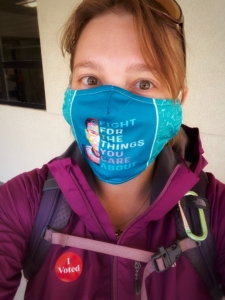
This selfie was taken just after I cast my ballot during the early-voting period in Minnesota, October 2020.
Election day started at 6am. We set up the poll pads (iPads loaded with the voter registration software) that are used to register and log in voters, prepared ballots for the voters to use (this included counting the ballots in each pack and recording how many were there), ensured the ballot-counting machines were correctly programmed and ready for the day, and set up signs, arrows, and other equipment to help guide voters through the line and the poll area.
Voters were lined up nearly 30 minutes before we opened at 7am. I spent the first 3 hours sanitizing voting booths between voters and directing voters to the booths and then to the ballot-counting machines to deposit their ballot. We were very busy for the first 3 hours of the day. The energy was upbeat and uplifting. Most everyone was polite, patient, and just interested in casting their ballot, having their say in our government, and then going on with their day. Since where I live is a relatively small town (~25,000 people) I knew many of the people coming in to cast their ballot. Seeing familiar faces made the morning even better.
I spent the middle part of the day working the poll pads, logging in voters, verifying their information, and directing them where to pick-up a ballot. I registered about 20 voters during this time as well, many of them first-time voters. The process to register a voter was defined in the poll pad. The person had to provide proof of their identity and residency. We had to note the documentation they used to prove this information when we registered them. Everything was documented, regimented, and governed by rules. There was a paper trail as well. Every voter signed a slip of paper before they were given a ballot. Another slip of paper indicating they were given a ballot was also kept. At the end of the day, the number of ballots issued had to match the number of voters who were logged into the poll pads and the number of ballots issued. If a ballot was “spoiled,” meaning a voter made a mistake when filling it out, it was also noted, tracked, and kept in specially marked envelopes to prevent them from being mixed with the valid ballots submitted. Voters were NOT allowed to have their vote counted twice. The poll pad noted if someone had already voted absentee and would not allow another ballot to be issued for that voter. The poll pads also noted if a voter needed to be “challenged.” To be challenged means that a question or other piece of information needs to be clarified/proven regarding the voter’s eligibility. The poll pad tells the poll worker what question to ask/information to collect from the voter. This challenge must be addressed and in a specific manner with proper documentation before the voter is allowed to complete their ballot.
Over the course of the day, we handled between 3,500 and 4,000 voters. Since I spent the last hour of my 14+ hour day sanitizing voting booths, I didn’t check the information on the poll pads to get a final count. The polls closed at 8pm. Once we collected the paperwork from the day, secured the ballots in boxes that were zip-tied shut to prevent tampering, and broke down the voting booths and poll pads, my day as an election judge was complete.
What I witnessed on election day was 40-50 election judges who just wanted to make election day safe and fair. They wanted to do their best so people could come in and fairly cast their vote. They wanted the results to reflect the voice of the voters, not any particular candidate. There were election judges from multiple political parties, working together to help Americans vote and keep the process fair so the voices of the voters could be heard. No voter was allowed to submit multiple ballots, no ballots were magically created to favor a candidate. Ensuring that all ballots are counted is not fraudulent. Democracy takes time and verifying and counting all ballots is one of those tasks to ensure that the people get to have their voice heard fairly. Some states accept mail-in ballots up to a week after the election as long as they are postmarked by election day. These ballots are not “late” simply because they arrived after election day. As long as they are received in the time frame outlined by the voting laws of that state, they can be counted.
It is a modern idea that we should know the results of our elections on election day. The reality is that we have never had the final election results on election day. The results provided to us on election day are mostly mathematical predictions of who is most likely to win. The final vote counting has always stretched on weeks after election day. Just because we don’t “know” who won the election on election day isn’t a sign of voter fraud. It’s a sign that a lot of people voted and that election officials are being very careful to verify and count every vote to ensure a fair election. This is the foundation of our democracy.
What my research told me was that there are many checks and balances in place to ensure our elections are fair. While I can’t speak to specifics in other states, the votes cast in Minnesota were done so fairly based on the rules in place and my observations as an election judge. Rather than listen to others who have their own agenda, I had experience and information that I gathered myself to tell me the truth.
I encourage you to learn more about the voting regulations for your state and serve as an election judge at least once to see how the process works first hand. It is an amazing way to support our democracy, keep our elections fair, and educate yourself on how our elections laws are structured and the votes of the people are counted and protected from fraud.
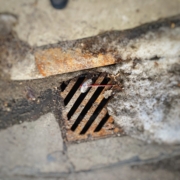 © Catherine Haslag
© Catherine Haslag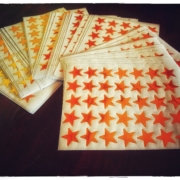 © Catherine Haslag
© Catherine Haslag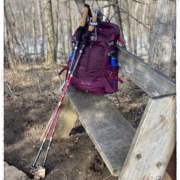 © Catherine Haslag
© Catherine Haslag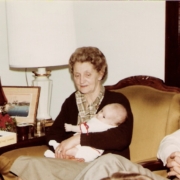 © Catherine Haslag
© Catherine Haslag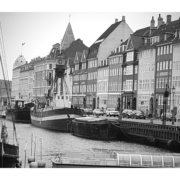 © Catherine Haslag
© Catherine Haslag
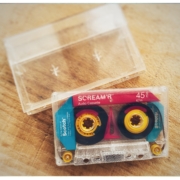 © Catherine Haslag
© Catherine Haslag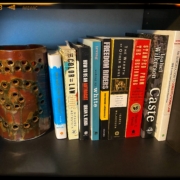 © Catherine Haslag
© Catherine Haslag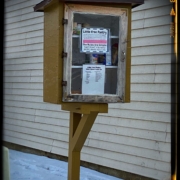 © Catherine Haslag
© Catherine Haslag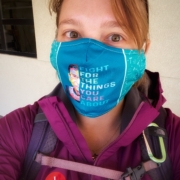 © Catherine Haslag
© Catherine Haslag